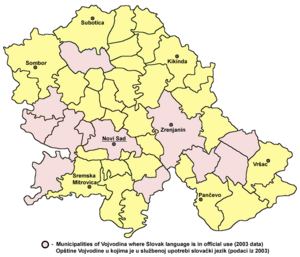Slovak language facts for kids
Quick facts for kids Slovak |
||||
|---|---|---|---|---|
| slovenčina, slovenský jazyk | ||||
| Native to | Slovakia; minority language in Czech Republic, Serbia, Hungary | |||
| Native speakers | over 7 million (2001 census) | |||
| Language family | ||||
| Writing system | Latin (Slovak alphabet) Slovak Braille |
|||
| Official status | ||||
| Official language in | Recognised minority language in: |
|||
| Regulated by | Ministry of Culture of the Slovak Republic | |||
| Linguasphere | 53-AAA-db < 53-AAA-b...-d | |||
|
||||
Slovak is the main language spoken in Slovakia. Slovakia is a country located in central Europe. Slovak is part of the Slavic language family. This group also includes languages like Russian and Polish. Many other languages from Eastern Europe are also Slavic.
Slovak is very similar to the Czech language. People who speak Czech and Slovak can usually understand each other well. Polish and Sorbian are also quite similar to Slovak. Over 5 million people in Slovakia speak Slovak.
Contents
How is Slovak Pronounced?
Slovak uses the Roman, or Latin, alphabet for writing. However, some letters have special marks called “diacritics”. These marks change how a letter sounds.
Special Consonant Sounds
Some Slovak letters sound like English sounds:
- The letter č sounds like 'ch' in chin.
- The letter š sounds like 'sh' in shin.
- The letter ž sounds like 's' in vision.
- The letter dž sounds like 'j' in juice.
Other letters are called “soft consonants”. These are ď, ľ, ň, and ť. You say them by placing the middle of your tongue against the roof of your mouth.
The letters c, dz, and j are also soft:
- c sounds like 'ts' in bats.
- dz sounds like 'ds' in rods.
- j sounds like 'y' in yes.
Vowel Sounds and Stress
A special mark over a vowel means it is pronounced for a longer time. These long vowels are á, é, í, ó, ý, and ú. A long vowel is never followed by a short vowel in the next part of the word.
The letter ô sounds like 'wo' in wombat. The letter ä sounds the same as the letter e.
The combination ch sounds like 'ch' in Scottish loch. The letter v sounds more like the English 'w'.
Some letters like b, d, ď, dz, dž, g, h, z, and ž become voiceless when they are at the end of a word. For example, 'd' at the end of a word will sound like 't'.
In Slovak, the stress is always on the first syllable of a word. This is different from languages like Russian, where the stress can be on any syllable.
Slovak can be tricky for English speakers to pronounce. This is because many consonants often appear together. For example, the sentence “Strč prst skrz krk!” has no vowels at all! It means “Stick a finger through your neck!”
Understanding Slovak Grammar
Slovak grammar is similar to Russian grammar, but there are some key differences.
Verbs: To Have and To Be
Unlike Russian, Slovak uses words for “to have” and “to be”.
- Ja som Angličan means “I am English”.
- (Ja) mám kufor means “I have a suitcase”.
Slovak does not use articles. Articles are words like “the” or “a” in English. So, you just say “suitcase” instead of “a suitcase”.
Nouns and Genders
Slovak has three genders for nouns: masculine, feminine, or neuter. You need to know a noun's gender to use the correct ending for adjectives that describe it. There are no articles to help you know the gender, so you just have to learn it.
Verb Forms and Cases
Like many European languages, Slovak verbs change based on who is doing the action. This means there are different forms for 'I', 'you', 'he', and so on.
Verbs also have different aspects. These aspects show if an action is finished or still happening.
Slovak also uses different cases. Cases show the role a word plays in a sentence. Different prepositions (like 'in', 'on', 'to') need to be followed by words in specific cases. All these rules can make Slovak grammar quite complex for English speakers.
Useful Slovak Words and Phrases
Here are some common Slovak words and phrases you might hear:
Numbers
The numbers from 1 to 10 are:
- jeden (one)
- dva (two)
- tri (three)
- štyri (four)
- päť (five)
- šesť (six)
- sedem (seven)
- osem (eight)
- deväť (nine)
- desať (ten)
Greetings and Common Phrases
Slovak has different ways to say things depending on if you are talking to a child or an adult. Use the familiar form for children and the polite form for adults.
- Ahoj – Hello (familiar)
- Dobré ráno – Good morning
- Dobrý deň – Good day (used during the day)
- Dobrý večer – Good evening
- Dobrú noc – Good night
- Vitaj! – Welcome! (familiar)
- Vitajte! – Welcome! (polite)
- Volám sa John – My name is John (Literally: I call myself John)
- Ako sa voláš? – What is your name? (familiar)
- Ako sa voláte? – What is your name? (polite)
- Ja som Američan – I am American (if the speaker is male)
- Ja som Američanka – I am American (if the speaker is female)
- Ako sa maš? – How are you? (familiar)
- Ako sa máte? – How are you? (polite)
- Ďakujem, dobre – Thank you, I am well
- Ujde to – Not too bad
- Zle! – Bad!
- Prosím – Please
- Ďakujem – Thank you
- Nech sa páči/Nie je za čo – You are welcome (this is a reply to “Ďakujem”)
- Dobrú chuť – Enjoy your meal
Images for kids
See also
 In Spanish: Idioma eslovaco para niños
In Spanish: Idioma eslovaco para niños



